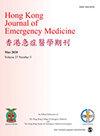Identification of practically important traumatic brain injury using Pediatric Emergency Care Applied Research Network rule in children younger than 2 years with minor head trauma
IF 0.8
4区 医学
Q4 EMERGENCY MEDICINE
引用次数: 1
Abstract
Background: Minor head trauma is frequently presented to the pediatric emergency department. Despite the burden this injury poses on public health, evidence-based clinical guidelines on the assessment and management of pediatric minor head trauma remain unestablished, particularly in children below 2 years. We aimed to assess the diagnostic accuracy of a clinical decision rule (Pediatric Emergency Care Applied Research Network rule) and physician discretion in the recognition of practically important traumatic brain injury in children below 2 years of age presenting with minor head trauma to the emergency department. Methods: The medical records of children younger than 2 years presenting with head trauma to the emergency department were reviewed with Glasgow Coma Scale scores of 14–15. Practically important traumatic brain injury is a clinically essential traumatic brain injury including all cranial abnormalities (e.g. skull fracture) detected by computed tomography. All predictor variables of the Pediatric Emergency Care Applied Research Network rule and practically important traumatic brain injury outcomes were validated. Results: We enrolled and analyzed 433 children below 2 years. The most frequently observed mechanisms of injury in decreasing order were as follows: falls > 90 cm, head struck by high-impact objects, slip down, and automobile traffic accident. Of 224 children, positive findings were observed in 35 and 144 had one or more predictors of Pediatric Emergency Care Applied Research Network rule. The sensitivity, specificity, and negative likelihood ratio of the Pediatric Emergency Care Applied Research Network rule for practically important traumatic brain injury were 94.3%, 41.3%, and 0.14, respectively. Conclusion: The Pediatric Emergency Care Applied Research Network rule would assist in clinical decision-making to appropriately detect potential head injuries in children below 2 years, thereby reducing unnecessary performance of computed tomography scan.使用儿科急救应用研究网络规则识别2岁以下儿童的实际重要创伤性脑损伤 头部轻微创伤数年
背景:轻微的头部创伤经常出现在儿科急诊科。尽管这种损伤给公共卫生带来了负担,但关于儿童轻微头部创伤评估和管理的循证临床指南仍然没有制定,尤其是在2岁以下的儿童中 年。我们旨在评估临床决策规则(儿科急诊应用研究网络规则)和医生自由裁量权在2岁以下儿童实际重要创伤性脑损伤识别中的诊断准确性 年,因轻微头部外伤到急诊科就诊。方法:对2岁以下儿童的病历资料进行分析 采用格拉斯哥昏迷量表(Glasgow Coma Scale)14-15分对急诊科出现头部创伤的年份进行了回顾。实用上重要的创伤性脑损伤是一种临床上重要的创伤性脑损伤,包括通过计算机断层扫描检测到的所有颅骨异常(如颅骨骨折)。验证了儿科急诊应用研究网络规则的所有预测变量和实际重要的创伤性脑损伤结果。结果:我们招募并分析了433名2岁以下儿童 年。最常见的损伤机制按递减顺序如下:跌倒 > 90 厘米,头部被高冲击物撞击,滑倒,发生汽车交通事故。在224名儿童中,35名儿童观察到阳性结果,144名儿童有一个或多个儿科急诊应用研究网络规则的预测因素。儿科急诊应用研究网络规则对实际重要创伤性脑损伤的敏感性、特异性和负似然比分别为94.3%、41.3%和0.14。结论:儿科急救应用研究网络规则将有助于临床决策,以适当检测2岁以下儿童的潜在头部损伤 从而减少计算机断层扫描的不必要性能。
本文章由计算机程序翻译,如有差异,请以英文原文为准。
求助全文
约1分钟内获得全文
求助全文
来源期刊

Hong Kong Journal of Emergency Medicine
EMERGENCY MEDICINE-
CiteScore
1.50
自引率
16.70%
发文量
26
审稿时长
6-12 weeks
期刊介绍:
The Hong Kong Journal of Emergency Medicine is a peer-reviewed, open access journal which focusses on all aspects of clinical practice and emergency medicine research in the hospital and pre-hospital setting.
 求助内容:
求助内容: 应助结果提醒方式:
应助结果提醒方式:


